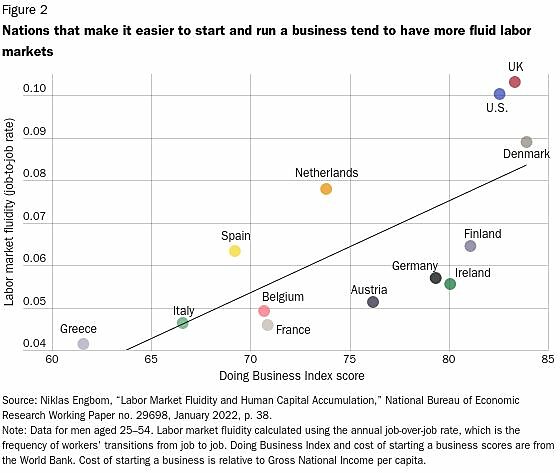"The U.S. mid‐term election cycle brought mixed results on state and local ballot measures determining wage and employment laws.
Nebraskan voters approved a minimum wage hike from $9 per hour to $15 per hour by 2026, as DC voters opted to mandate that tipped workers’ minimums rise from $5.35 per hour to $16.10 per hour by 2027.
Ballot measures in Laguna Beach, California and elsewhere looking to introduce special minimum wages for staff in particular industries (such as hotel staff) genuinely failed. Illinois voters opted to enshrine a state constitutional amendment for the right to collectively bargain, whereas Tennessee voters opted to enshrine a right‐to‐work law as an amendment to their constitution.
These changes remind us of the large role governments play already in our labor markets and how contentious this can be. Internationally, the U.S. has relatively lightly regulated jobs markets. However, over the past century, workers’ freedom to contract and U.S. businesses’ freedom to hire and fire at‐will have still been substantially watered down here, even if other countries have gone much further in curbing these freedoms.
U.S. anti‐discrimination laws affect firms’ recruitment and layoff decisions and there are restrictions for businesses in many states on what they can ask about would‐be employees’ criminal histories. Minimum wage laws, overtime pay regulation, restrictions on independent contracting, and forced unionization can create legal obligations for firms to provide pay, conditions, or benefits which they and individual workers in free negotiation might otherwise spurn.
All such policies tend to be predicated on an adversarial model of worker and management interests, with policymakers swooping in to “protect” workers from their bosses by imposing mandates on business or threats of fines for actions deemed unfair. In public debates, most such laws and regulations are therefore assumed to benefit “American workers” as a cohort.
Yet in my chapter of the Empowering The New American Worker book, I explain how basic economic analysis (confirmed by empirical evidence) tells us that, at best, these policies tend to help some workers enjoy more security or higher pay or benefits at the expense of others, who often suffer heavily. At worst, they raise the overall costs and risks of mutually beneficial job agreements, reducing net opportunities, harming business productivity, or distorting remuneration packages in ways that harm employees.
What’s more, in recent years, there has been political momentum – mainly from the left, but also the national conservative right – for expanding U.S. labor regulation in a more highly regulated “European” direction, with stricter mandates on contract provisions and greater curbs on firms’ ability to freely recruit or layoff workers. These have included a push for a $15 federal minimum wage, government encouragement of collective bargaining agreements, shoehorning gig economy and other independent workers into traditional employee‐employer regulatory frameworks and rolling out predictive scheduling laws.
This direction of travel is an error. First, because cross‐country evidence suggests that restrictive labor market regulations raise the structural level of unemployment, particularly for demographic groups with the weakest attachment to the labor market, such as young and unskilled workers. Prior to the pandemic, for men and women, the EU (which has much more stringent labor laws, on average) saw youth unemployment rates (15–24 percent) of 15.3 percent and 14.8 percent, against just 9.4 percent and 7.3 percent in the U.S.
Second, because recent research by Niklas Engbom has found that policies and regulations that make hiring workers more expensive or risky also reduce job‐to‐job fluidity, which itself is strongly associated with better life‐cycle wage growth for workers. Given that the U.S. had already seen a sustained reduction in the movement of workers to new jobs or states prior to the pandemic – over a period associated with weaker productivity and wage growth – moving in this direction would amount to compounding some of the problems that have afflicted the economy over the past two decades.
Indeed, although burdensome laws that have existed for years cannot logically explain recent decades’ labor fluidity declines, undoing some existing policy could permanently raise the level of U.S. labor market dynamism and improve productivity levels, much to American workers’ overall benefit.
Legislators should be looking to row back on existing labor market regulation, rather than adding more hurdles to employers and employees freely negotiating what they perceive to be mutually beneficial workplace relationships."
Thursday, November 17, 2022
Why We Should Care About U.S. Labor Market Regulation
Subscribe to:
Post Comments (Atom)

No comments:
Post a Comment
Note: Only a member of this blog may post a comment.